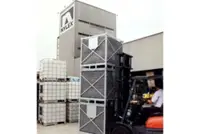KUCHING: Sarawak Plantation Bhd has aggressively pursued oil palm replanting, covering some 4,200ha last year to bolster future crop production growth.
has aggressively pursued oil palm replanting, covering some 4,200ha last year to bolster future crop production growth.
This achievement, according to executive director Datuk Wong Kuo Hea, was the result of meticulous planning and efficient execution, exceeding the company’s replanting target by 5%.
He added that RM54mil in capital expenditure was incurred on replanting and maintaining the group’s existing immature estates in 2024.
This was more than double the RM25.1mil spent on the replanting programme and estate maintenance in 2023.
“Replanting is a significant milestone for the group because it ensures long-term sustainable growth. Low-yielding old mature fields, as well as severe ganoderma infested areas, are replanted in stages.
“These areas were replanted with high-yielding seeds and are expected to drive up production growth in the coming years,” he said in the company’s 2024 annual report.
The high-quality seeds used were sourced from Sarawak Plantation’s own nurseries, which also saw an 86% increase in sales, reaching 930,000 seeds to external parties last year compared to 2023.
As one of the pioneers in Sarawak’s oil palm industry, the Miri-based group has a total landbank of 42,166ha, with an additional 412ha under a joint-venture development with a state agency.
The plantable area totals about 36,232ha.
Currently, the group owns 13 oil palm estates and two palm oil mills across northern and central Sarawak.
Sarawak Plantation is an associate of Ta Ann Holdings Bhd , its largest shareholder with a 29.4% equity interest.
, its largest shareholder with a 29.4% equity interest.
Wong, also managing director/CEO of Ta Ann, noted that Sarawak Plantation had successfully normalised almost the entire 6,000ha of oil palm areas identified in 2018 for improvement and enhancement, including 400ha rehabilitated last year.
The remaining 20ha are expected to be normalised this year.
On areas of the group’s plantations which were encumbered by local villagers, Wong said via engagements with them, the group successfully resolved 100ha last year, bringing the total recovered area to some 4,300ha since 2018. Around 2,100ha of matured areas remain encumbered.
Despite the challenges in recovering these areas, the group remains dedicated in rehabilitating all, or at least the majority, of these areas.
In 2024, Sarawak Plantation declared 1,500ha of oil palms as matured, with young mature palms (four to six years) accounting for 9% and prime mature palms (seven to 20 years) comprising 59%. Immature and old mature palms (over 21 years) made up 25% and 7%, respectively.
Sarawak Plantation also launched its own-designed and developed oil palm harvesting machines called “Lipan” last year, as it shifts towards field mechanisation from the traditional labour-intensive harvesting method.
These machines are equipped with wireless control, enabling operators to manage the harvesting process easily and efficiently.
Another research initiative currently in trial is a six-wheeler, adopted from logging operations and modified to navigate rugged and hilly terrains for fresh fruit bunch (FFB) evacuation.
Once further design iterations are completed, these machines are expected to serve the group’s new planting areas, which are being designed for mechanisation in the future.
Wong said the group is expanding the use of “Lipan” in suitable harvesting areas and will continue to monitor and enhance their performance.
Currently, 10 harvesting machines are operational across the group’s plantations.
“Embracing mechanisation for harvesting and other field operations is a sustainable approach to reducing labour dependency. The group also believes that mechanisation offers many benefits, including increased efficiency and enhanced sustainable practices.”
He said Sarawak Plantation’s action plans for 2025 include executing effective replanting strategies to optimise planting density and expand harvesting path for future mechanised opportunities, while maintaining the yield potential of the oil palms.
The group is also accelerating replanting efforts in low-yielding areas, regions severely affected by Ganorderma infestation, and areas with low palm stands, alongside recovering more encumbered areas and old mature fields.
It plans to expand the facilities and production capacity of its three oil palm nurseries, which currently have the capacity to grow up to 1.2 million seedlings a year.
The high-yielding and genetically superior seeds, branded “Surea DxP”, have shown to produce high FFB and oil yields.
These seeds have been tested and confirmed to exhibit a moderately slow height increment, Wong added, ensuring stable yields over time while minimising the risk of disease outbreaks in the estates. — By JACK WONG





